Delightfully embroidered pincushions are a combination of beauty and functionality. They often hold a multitude of pins complimented with embroidered designs. The quantity and variety of pins is often surprising. In the 20th century, pins were still considered a mainstay of a well-outfitted household. Sometimes pins were described as “indispensable to the comfort, happiness and harmony of extistence.” (1)
Pincushions make great gifts. The 1908 issue of American Motherhood recommends “A fancy pincushion filled with all sorts and sizes of pins makes a good present. Made to look like a small mattress, around the sides are fastened various pins of every color and obtainable size.” (2)
In a 1919 issue of House Beautiful, a pincushion is offered for sale for $2 plus postage—about $25 in today’s dollars. It is described as satin and filled with pins of all colors. They promise it is so filled with pins that it will “last for some time.” No details are provided on the size, pin quantity, or design, however. While embroidery isn’t mentioned in either example, makers always like to give beautiful gifts and found ways to embellish the pincushion.
The Crescent hanging pincushion measures 6” wide and 4” High. The hanging ribbon is 6” long. The five different types and colors of pins are artistically arranged to compliment the crescent shape. Along the seam lines, pins are arranged in groups of 7 to create a flower design. There are 30 brass .75” safety pins along the edge. Other pin types include glass-head straight pins in various sizes and colors.
Colored pins were an important feature in the 20th-century pincushion. Common straight pins were readily available with colored heads–a rainbow of options compared to the silver, white, and black pins of the previous century. Safety pins in a couple of styles and numerous sizes were also sold in an assortment of colors. The pins were painted in fashionable colors. Quick repairs to readymade clothing and colorful home furnishings could be done quickly with a pin that blended in with the textile color. Later, more permanent repairs could be made.
Popular embroidery themes in these 20th-century pincushions include flowers and other feminine images like fanciful gowned females. The embroidery was done in thread made from wool, silk, and rayon. Stitches included French knots, lazy daisy, and satin stitch. The embroidery is usually very well done and wears better than the silky ground used for the body of the cushion. Often a pin or two is missing–possible proof that the pincushions were used.
This feminine embroidered pincushion measures 5.5” square. The gown is made from gathered gold gilt edged ribbon and ivory lace. She is surrounded in embroidered flowers. Barely showing around the velvet edge are the heads of almost 200 straight pins. The outer edge is piped in velvet ribbon. Colored safety pins in green, blue, black, pink, gold, and silver fill the cushion edge. The handle is a 12” velvet hanging ribbon.
The pins were very artfully arranged in the pincushions to create secondary patterns. In one example, straight pin heads create petaled flowers when pinned in circular groups of seven. Colored straight pin heads are pinned in curves and circles that enhance the embroidered designs and the shape of the cushion. The safety pins are often grouped by color and size and then pinned along the edge of the cushion.

Measuring just 3” x 4” this embroidered pin cushion contains almost 200 pins in 8 styles. The satin-like yellow ground material is embroidered with leaves and flowers using wool thread. The pastel embroidery is enhanced by the yellow background.
It is possible that some of the 20th-century pincushions were made from kits or published designs. Regardless, makers were sure to add their own touches to make each cushion unique. Whether it was adding a favorite motif, adding a favorite stitch, or changing the colors, each cushion is a small, fanciful, and useful treasure.
Resources
- Pins and Pincushions by Longman and Loch, 1911
- American Motherhood Volumes 26-27, page 27
Dawn Cook Ronningen is a Minnesota-based writer, designer, collector, and instructor. She is the author of Antique American Needlework Tools (Schiffer publishing, 2018). See more on Instagram and Facebook @dawncookronningen and on her blog, "Collector With A Needle."

